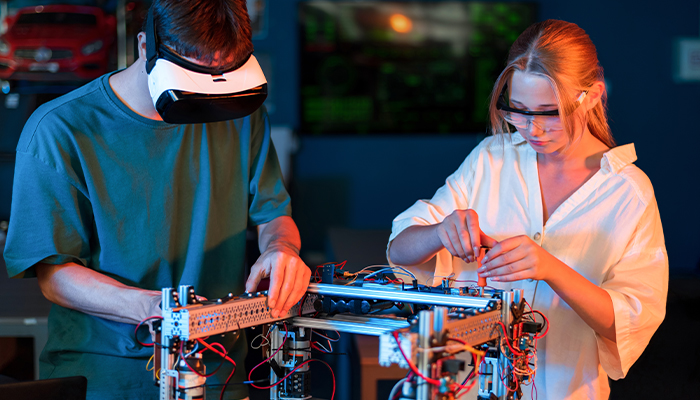Robotics and Automation: Impacts of the Future of Work

APR, 17, 2024 14:00 PM
Robotics and Automation: Impacts of the Future of Work
In the realm of modern industry, robotics and automation stand as pillars of innovation, revolutionizing the way we work. Robotics refers to the branch of technology that deals with the design, construction, operation, and use of robots. On the other hand, automation involves the use of various control systems for operating equipment, machinery, processes, or even entire systems with minimal human intervention. Together, robotics and automation have become indispensable tools across diverse sectors, reshaping workflows and redefining the future of work.
Definition and Benefits:
Robotics encompasses a wide array of machines equipped with mechanical arms, sensors, and programming to perform tasks autonomously or semi-autonomously. Automation, on the other hand, involves the application of technology to streamline processes, reduce human intervention, and improve efficiency. The benefits of robotics and automation are manifold. They enhance productivity by executing repetitive tasks with precision and consistency, leading to increased output and cost savings. Moreover, automation minimizes human error, improves safety in hazardous environments, and enables operations to run 24/7, enhancing overall efficiency and competitiveness.
In addition to enhancing productivity and efficiency, robotics and automation offer numerous other benefits that contribute to the advancement of industries and economies worldwide. One significant advantage is the ability to optimize resource utilization. By automating processes, businesses can more effectively allocate resources such as time, labor, and materials, maximizing their efficiency and reducing waste.
Furthermore, robotics and automation play a crucial role in improving product quality and consistency. Machines equipped with advanced sensors and precision control systems can perform tasks with unparalleled accuracy, ensuring uniformity in manufacturing processes and minimizing defects. This not only enhances customer satisfaction but also reduces rework and associated costs.
Another key benefit of robotics and automation is their capacity to adapt rapidly to changing demands and environments. Unlike human workers, machines are not subject to fatigue or fluctuations in performance, allowing them to maintain consistent output levels over extended periods of time. This flexibility enables businesses to respond more effectively to market fluctuations, customer preferences, and unforeseen disruptions, enhancing their resilience and agility in dynamic business environments.
Moreover, robotics and automation contribute to workplace safety by automating hazardous or physically demanding tasks that pose risks to human workers. By delegating such tasks to machines, employers can reduce the likelihood of workplace accidents and injuries, ensuring a safer working environment for their employees.
Additionally, robotics and automation facilitate the collection and analysis of data, providing valuable insights into operational performance, product quality, and customer behavior. By leveraging data analytics, businesses can identify opportunities for optimization, innovation, and growth, driving continuous improvement and competitive advantage.
Overall, the benefits of robotics and automation extend far beyond mere efficiency gains. From optimizing resource utilization and improving product quality to enhancing workplace safety and enabling data-driven decision-making, these technologies play a pivotal role in shaping the future of work and driving economic prosperity. As businesses continue to embrace robotics and automation, they will unlock new opportunities for innovation, growth, and sustainability in a rapidly evolving global landscape.
Impact:

Robotic Revolution:
The integration of robotics and automation into various industries marks a significant shift in the way we approach work. Initially confined to manufacturing, robotics and automation have now expanded their reach into diverse sectors such as healthcare, agriculture, retail, and transportation. Advancements in artificial intelligence (AI) have propelled this revolution, endowing robots with cognitive abilities that enable them to perform intricate tasks previously reserved for humans. Whether it's autonomous vehicles navigating city streets, delivery drones dropping packages at doorsteps, surgical robots assisting in delicate procedures, or automated customer service agents handling inquiries, the infusion of robotics is fundamentally reshaping workflows and business models across the board.
In healthcare, surgical robots have revolutionized medical procedures, offering enhanced precision, reduced invasiveness, and shorter recovery times for patients. In agriculture, automated drones and robotic harvesters optimize crop management and increase agricultural yields. In retail, robotic warehouses and automated checkout systems streamline logistics and enhance the customer shopping experience. In transportation, autonomous vehicles promise safer and more efficient mobility solutions, revolutionizing the way people and goods are transported.
Enhanced Productivity and Efficiency:
One of the most notable impacts of robotics and automation on the future of work is the substantial boost in productivity and efficiency. Machines equipped with advanced algorithms and sensors can tirelessly execute repetitive tasks with unparalleled precision and consistency, significantly reducing errors and maximizing output. This heightened efficiency allows businesses to streamline operations, optimize resource utilization, and expedite the delivery of products and services to meet the ever-evolving demands of consumers. By automating mundane and time-consuming processes, companies can redirect human efforts towards more strategic endeavors, fostering innovation and growth.
Automation not only accelerates the pace of production but also ensures consistency and quality of output. In manufacturing, robotic assembly lines can work around the clock with minimal downtime, leading to higher production rates and lower costs per unit. In customer service, chatbots and virtual assistants provide immediate support to customers, reducing response times and enhancing satisfaction levels. In logistics, automated inventory management systems optimize stock levels and minimize the risk of stockouts or overstocking, leading to improved supply chain efficiency.
Job Displacement vs. Job Transformation:
The rapid adoption of robotics and automation has sparked debates about job displacement and the future of employment. While it's undeniable that certain roles may become obsolete due to automation, the overarching narrative is one of job transformation rather than outright elimination. As routine tasks are automated, human workers are liberated to focus on higher-value activities that necessitate creativity, critical thinking, and emotional intelligence qualities that machines cannot replicate. Moreover, the integration of robotics often creates new job opportunities in emerging fields such as robot maintenance, software development, and data analysis, fostering a dynamic and evolving workforce.
The rise of automation necessitates a paradigm shift in the skills and competencies required in the workforce. Jobs that are repetitive and rule-based are more susceptible to automation, while roles that require human judgment, empathy, and creativity are likely to remain in demand. Therefore, there is a growing emphasis on upskilling and reskilling initiatives to equip workers with the necessary capabilities to thrive in an automated environment. Companies are investing in training programs, apprenticeships, and lifelong learning opportunities to empower their workforce and ensure they remain competitive in the labor market.
Upskilling and reskilling:
In light of the evolving nature of work propelled by robotics and AI services, employees must continually upskill and reskill to remain competitive in the labor market. As job roles evolve and technologies advance, individuals need to adapt and acquire new competencies to stay relevant in their respective fields. Companies play a pivotal role in facilitating this transition by investing in training programs, fostering a culture of continuous learning, and providing avenues for professional development. By empowering their workforce with the requisite skills to leverage automation technologies effectively, organizations can nurture talent, drive innovation, and maintain a competitive edge in a rapidly changing landscape.
Upskilling and reskilling initiatives are crucial for ensuring the workforce remains agile and adaptable in the face of technological advancements. Employees need to acquire skills such as digital literacy, data analysis, problem-solving, and adaptability to thrive in an increasingly automated world. Continuous learning and professional development opportunities are essential for staying abreast of industry trends, acquiring new technologies, and enhancing job performance. Companies that prioritize employee development not only foster a culture of innovation and growth but also attract and retain top talent in the competitive marketplace.
Human-Robot Collaboration:
Contrary to popular apprehensions about robots replacing human workers, the future of work hinges on fostering collaboration between humans and machines. Collaborative robots, or cobots, are designed to work alongside humans, augmenting productivity and safety in various settings. By capitalizing on the complementary strengths of humans and robots, businesses can cultivate synergistic work environments where automation enhances human capabilities, leading to heightened efficiency and innovation. This paradigm shift towards human-robot collaboration not only optimizes operational performance but also paves the way for new opportunities and advancements in the workplace.
Human-robot collaboration offers several advantages over traditional automation approaches. Cobots are designed to be flexible, adaptable, and easy to integrate into existing workflows, allowing for seamless interaction between humans and machines. In manufacturing, cobots can assist human workers with repetitive or physically demanding tasks, reducing the risk of ergonomic injuries and enhancing overall productivity. In healthcare, collaborative robots can support medical professionals in patient care, medication dispensing, and rehabilitation exercises, improving the quality of care and patient outcomes. In logistics, cobots can work alongside warehouse staff to pick, pack, and sort items, increasing order fulfillment rates and reducing turnaround times.
Ethical and social considerations:
As robotics and automation continue to proliferate, it is imperative to address the ethical and societal implications accompanying their widespread adoption. Concerns regarding job displacement, data privacy, algorithmic bias, and the ethical use of AI necessitate careful consideration and proactive measures. Policymakers, businesses, and researchers must collaborate to establish regulatory frameworks that ensure the responsible deployment of robotics and AI technologies, safeguarding the interests of workers and society at large.
Ethical considerations are paramount in ensuring that the benefits of robotics and automation are distributed equitably across society. Measures must be taken to mitigate the risk of job displacement and ensure that vulnerable populations are not left behind in the transition to an automated workforce. Companies have a responsibility to prioritize employee well-being, fair labor practices, and diversity and inclusion initiatives in their automation strategies. Transparency and accountability are essential in algorithmic decision-making processes to prevent biases and discrimination.
Moreover, data privacy and cybersecurity concerns must be addressed to protect sensitive information and prevent unauthorized access to autonomous systems. Regulations and standards should be established to govern the collection, storage, and use of data by robotics and automation technologies, ensuring compliance with ethical principles and legal requirements. Additionally, efforts should be made to foster public awareness and engagement regarding the ethical implications of robotics and automation, encouraging dialogue and collaboration among stakeholders to navigate these complex issues responsibly.
Conclusion
In conclusion, robotics and automation represent a transformative force in the modern workforce. These technologies offer unparalleled opportunities to enhance productivity, efficiency, and safety across various industries. However, their impact goes beyond mere operational improvements. Robotics and automation are catalysts for innovation, driving the evolution of work and creating new possibilities for human-machine collaboration. As we embrace these advancements, it is essential to navigate the ethical, societal, and economic implications thoughtfully. By harnessing the potential of robotics and automation responsibly, we can build a future where humans and machines work together harmoniously to create a more prosperous and sustainable world.




Strategy
Design
Blockchain Solution
Development
Launching
Testing
Maintenance
Contact US!
India

Plot 378-379, Udyog Vihar Phase 4 Rd, near nokia building, Electronic City, Phase IV, Sector 19, Gurugram, Haryana 122015
Copyright © 2026 PerfectionGeeks Technologies | All Rights Reserved | Policy
Strategy
Design
Blockchain Solution
Development
Contact US!
India 
Plot 378-379, Udyog Vihar Phase 4 Rd, near nokia building, Electronic City, Phase IV, Sector 19, Gurugram, Haryana 122015
USA 
1968 S. Coast Hwy, Laguna Beach, CA 92651, United States
Copyright © 2026 PerfectionGeeks Technologies | All Rights Reserved | Policy
